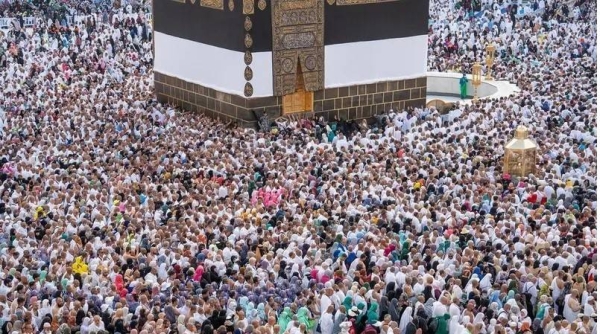Hundreds of thousands of Hajj pilgrims began the annual pilgrimage with the ritual of Tawaf Al-Qudum in Makkah on Thursday evening. This marked the beginning of the Hajj season, with pilgrims moving into the tent city of Mina to prepare for the Day of Tarwiyah on Friday. The General Authority for the Care of the Affairs of the Two Holy Mosques is working diligently to ensure all entrances and corridors leading to the mataf are clear and easily accessible for pilgrims. The mataf can accommodate a large number of worshipers per hour, providing a comfortable and smooth experience for those performing their rituals.
Pilgrims arriving in Makkah on Thursday performed the obligatory Tawaf Al-Qudoom before making their way to the tent city of Mina. Meanwhile, those who had arrived earlier were busy making final preparations for the upcoming days. The General Authority, along with other concerned authorities, are focused on ensuring that all resources and facilities are utilized to their full capacity in order to provide a seamless experience for the pilgrims. With the mataf accommodating a large number of worshipers per hour, the Grand Mosque is equipped to handle the influx of pilgrims during the Hajj season.
The mataf, which is the circumambulating area around the Holy Kaaba, has the capacity to accommodate 108,000 worshipers per hour on all its floors. This includes the courtyard, ground and first floors, first and second mezzanine floors, and the second rooftop floor. This ensures that pilgrims can perform their rituals with ease and comfort, without feeling overcrowded or overwhelmed. The authorities are committed to providing a safe and organized environment for all pilgrims, allowing them to focus on their spiritual journey and devotion during the Hajj season.
The rituals of Hajj hold great significance for Muslims around the world, as it is considered one of the five pillars of Islam. Pilgrims come from different countries and backgrounds to fulfill their religious duties and seek forgiveness and blessings during this sacred journey. With the support of the General Authority and other authorities, pilgrims are able to navigate the crowded spaces and perform their rituals with peace of mind. The Hajj pilgrimage is a time for reflection, prayer, and community, bringing together Muslims from diverse cultures and traditions in a spirit of unity and devotion.
As pilgrims move from Makkah to Mina and eventually to the plains of Arafat, they are guided by the teachings of Islam and the guidance of the Prophet Muhammad. The rituals of Hajj are a reminder of the importance of faith, devotion, and gratitude in the lives of Muslims. The support and facilities provided by the authorities ensure that pilgrims can focus on their spiritual journey, connecting with their faith and seeking blessings from Allah. The annual pilgrimage of Hajj is a time of renewal, reflection, and transformation, allowing pilgrims to deepen their connection to their religion and their community.
In conclusion, the beginning of the Hajj season in Makkah marks a time of spiritual significance and communal solidarity for Muslims around the world. The rituals of Tawaf Al-Qudum and the preparations in Mina set the stage for the days ahead, as pilgrims embark on a journey of prayer, reflection, and devotion. With the support of the General Authority and other authorities, pilgrims can perform their rituals in a safe and organized manner, allowing them to focus on their spiritual journey and seek blessings from Allah. The annual pilgrimage of Hajj is a time of renewal and transformation, bringing together Muslims from diverse backgrounds in a spirit of unity and devotion.











